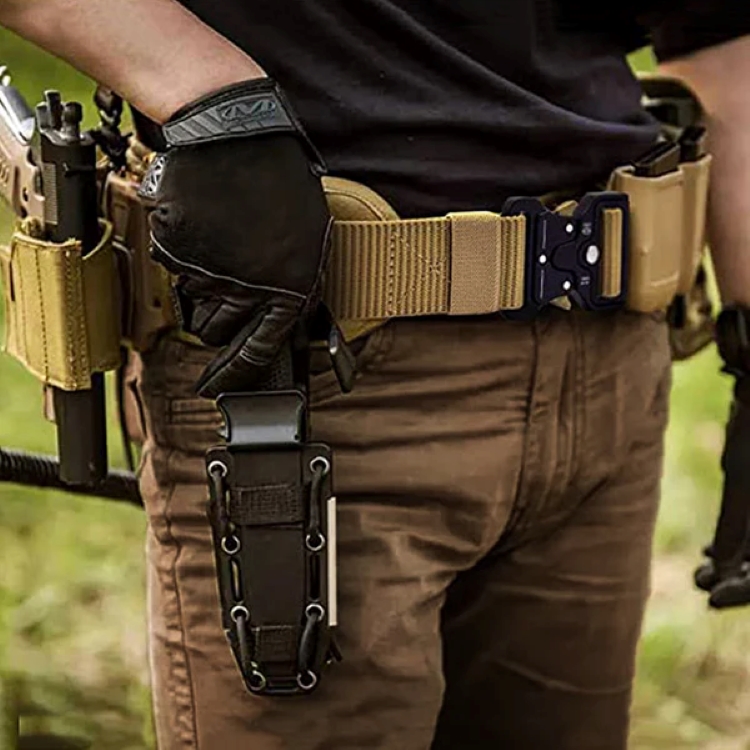People have been using tactical belts for thousands of years. Roman legionaries wore them to support protective gear and carry swords and pouches containing water and other necessities for the battlefield. These days, you can be ready for anything by wearing a basic rigger’s belt or investing in a full-featured tactical belt. Today, law enforcement and military departments worldwide have it right: tactical belts are an essential uniform component. That’s because their duties extend far beyond simply holding up military pants.
Why Wear a Tactical Belt?

source: instagram.com
A tactical belt is a heavy-duty belt made from durable, long-lasting materials such as bonded (webbed) nylon. It has a sturdy design for firearms, flashlights, knives, pens and multitools, and different pouches such as IFAK, utility and hydration. It significantly impacts how you wear your firearm and equipment, improving comfort, functionality and accessibility.
When you find the ideal military belt for your needs, you’ll benefit from mission-specific features like MOLLE compatibility, holster attachments for concealed carry and different multitool attachments. It’ll keep you on track, no matter what you’re doing. A high-quality military belt is rugged enough to help you carry all your equipment, yet flexible enough to allow unrestricted movement. It won’t droop when you holster or attach heavy ammunition and won’t impede your breathing at any time.
What to Look For in a Tactical Belt?
Make sure the tactical belt you choose meets the unique requirements of your equipment while also prioritising comfort and adaptability. Whether you hold knives, guns, or other emergency gear, your belt should make carrying and using it easier and more effective. The material it’s made of, its buckle type and rigidness are the three most critical factors to consider.
Materials
Although many tactical belts are constructed of nylon, it doesn’t guarantee that the belt is robust and long-lasting. It’s preferable to look for ones with reinforced stitching throughout and heavy-duty tensile strength. Some of the best options have multiple rows of this type of stitching to increase the stability and weight capacity of the belt. Nylon designs are breathable and light, drying quickly without adding to your weight. Even in more challenging circumstances, they’re also less likely to tear.
Certain tactical belts feature a leather pattern on them. Although they’re more frequently referred to as gun belts, their overall performance and function are very different. Most of the time, nylon is the best option due to its general robustness and functional flexibility.
Rigidity
The rigidity is crucial because it makes carrying all your equipment easier, meaning the belt won’t roll or twist when you move. Wider belts are stiffer, though that’s not true for some poor-quality options. But, they usually have the advantage of not sagging on you as much.
On the other hand, the belt might also be too rigid. In that case, carrying and wearing it is less comfortable, making it difficult to get long-term benefits.
Lastly, pick something intended for the load you intend to carry. You won’t need the most rigid belt if you plan to bring a much lighter pistol and not a lot of other gear. A stronger, more rigid design might be more task-appropriate if you carry a larger firearm, multiple magazines, or knives.
Buckle Type
The buckle is the next thing to consider. It comes in various styles:
- Fast-releasing buckle. Click the buttons on either side of the buckle to release it.
- Loop fastener. A straightforward hook and loop design that lets you secure the belt by passing it through a D link or other loops.
- Quick-release buckle. This belt is easy to position and remove with a simple snap.
- Frame buckle. These have a hollow box with two windows on the back of the buckle through which the belt slides to secure it.
A tactical belt with a flimsy or delicate buckle is more difficult to put on and take off. The strongest metal buckles are usually made of steel or aluminium, though some also include plastic. The ideal setup should have a wide range of sizes available to ensure you get a proper fit. Some offer micro-adjustable buckles, which are crucial for correct adjustability.
Choosing the Right Option for Your Needs
After you check factors like materials, rigidity and buckle type, and have an option in mind – you must ensure it fits your tasks in the field and your particular military needs. Only that way, you’ll choose the correct belt. Ask yourself the following questions:
- Retention: When drawing a magazine, a pistol, or other equipment, for example, how well does everything stay in place?
- Mobility: Is it preventing you from moving freely?
- Portability: Do you have to tuck your shirt in when you’re wearing it? For instance, how might it be worn with a jacket?
- Attachment capabilities: How do you attach your belongings, and how much room do you have to arrange them?

